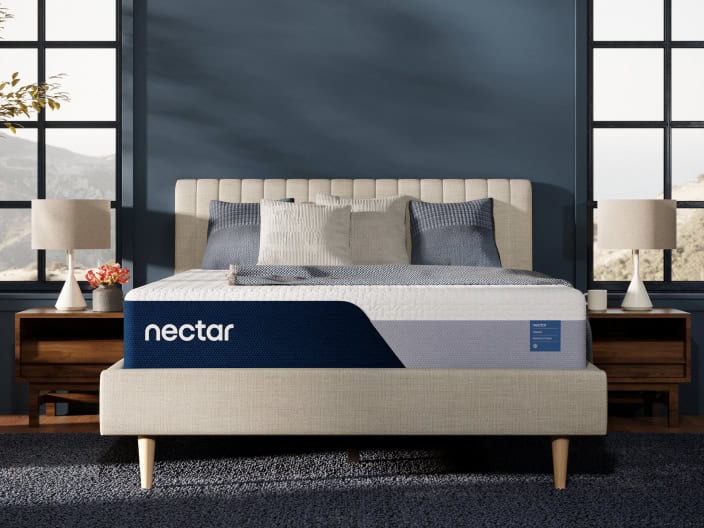Our Definitive Pillow Buying Guide
Share
Fact checked
Reviewed by experts
Updated
December 28, 2022
Quick read
8 mins to read
List of Content
A pillow can make you or it can break your sleep. Let’s get real – we’ve all endured our own unique pillow fights that have kept us up throughout the night. From punching the lumps in our down pillows to our constant search for the “cool” side when we sleep hot, we have all struggled when it comes to resting our head easy for the night.
While it’s common to stress about finding the perfect mattress, very few people put as much thought into their pillow purchase. However, the perfect pillow can help or hinder our sleep patterns so it’s important to make a good decision. In this article, we have explored the in’s and out’s of the most innovative pillow technology available today and all the information you need to choose the best pillow for you. The human body heals itself through sleep. Let’s give ourselves the gift of vitality by choosing wisely.
Top Reasons To Buy A Pillow
You aren’t alone – it’s fairly common to go pillow shopping. The top reasons people look to buy a new pillow are they are also purchasing a new mattress and want a whole new bed set, their current pillow is old and lumpy, or their current pillow is causing neck and/or shoulder pain. Also, you might consider a new pillow if you are suffering from allergies. Feather and down fillings have the potential to trigger allergies.
Many sleep experts recommend choosing a hypoallergenic pillow if you are prone to allergies. Bedding can attract certain allergens like dust mites, dander, mold, and dust. Battling these allergies can be challenging, but hypoallergenic pillows can help dramatically. Hypoallergenic pillows are made of specific fabrics and materials that help to keep allergens at bay. All of these are great reasons to buy a new pillow.
How Neck and Shoulder Pain Can Relate to Pillows
The significance of a good pillow should not be underestimated. Pillows provide essential support to the upper body throughout the night by keeping the neck and spine in a neutral alignment. The alignment of our neck and spine has a direct effect on our quality of sleep as well as present and future spinal health. The right pillow can vary according to the sleep position favored by each person. However, quality should never be forgone. Here’s how neck and shoulder pain can relate to pillows and why proper support matters when you sleep.
- Your spine will thank you. The proper pillow will save you from back problems or spinal injuries. Often, we incur injuries due to an accumulation of woes such as potentially damaging habitual sleep positions and improper spinal alignment over a long period of time. Ideally, you should choose a pillow that can effectively help you maintain spinal alignment in all of your varied sleeping positions throughout the night thus sparing your spine any strain or pain that can compound over years of falling asleep on mediocre pillows.
- Your neck needs support too! A great pillow aligns the head and neck with the back in a neutral and supportive position. Most people who suffer from neck, shoulder and back pain are oblivious to the culprit – their pillow. If you consistently wake up with bouts of neck stiffness or pain, it might be a sign that you need to examine the quality of your pillow and seek an alternative. The position of your head on the pillow should not be too high or low on your head and neck as this might create unnecessary muscle strain on your upper body while you
- Consider your pillow fillings. Natural fillings like buckwheat and feathers are going to provide less support. If you are a sleeper who is in need of or prefers more support, then explore orthopedic pillows or memory foam options. Like a memory foam mattress, memory foam pillows contour to your neck and shoulders.
Construction And Firmness
It’s a Goldilocks Zone scenario in finding just the right pillow for you. Some are firm. Some are soft. Some are in between. There are 3 different levels of pillow support with their own respective benefits to keep in mind:
- Medium Support – This will support the natural curvature of the upper spine, providing support under the head, neck, and shoulders.
- Firmer support – This will contour and cradle the head, neck, and shoulders.
- Soft support – A pillow that doesn’t turn the head unnaturally to either side will work best if you prefer soft support.
Cooling Technology in Pillow Construction
Night sweats can take toll on your sleep which directly affects your well being. When built into pillows, cooling technology helps you get the consistent, satisfying sleep you need. Cooling Technology Pillows literally absorb the heat energy from your body into the pillows themselves.
The Benefits of a Cooling Pillow
Aids in falling asleep quickly.
You’ve got your bedroom temperature set to a cool 60 degrees, but you’re still sweating. Cooling pillows create a surface which cools the head, lulls the body into sleep and helps you stay asleep.
Might help calm insomnia.
Fitful sleep can be torture. A cooling pillow keeps the head cool during the night which will help curb bouts of night sweats or overheating that can occur and cause insomnia.
Improves mental health.
When your sleep is disrupted, you end up energetically and mentally depleted. These damaging patterns can compound into a recurring depression. A well-rested body is a well-rested mind.
Keeps you looking younger
There is nothing like a bad night’s sleep to age the skin and face. Just as the body loses energy from lack of sleep, so does the face begin to droop with exhaustion.
Types of Cooling Pillows
- Breathable Pillows – a breathable pillow is designed to circulate airflow through the filling and in some cases through the pillow cover.
- Memory Foam Gel Pillows – gel memory pillows were introduced to help ventilate heat and combat that dreaded warming sensation. Typically, gel memory foam pillows feel cool initially, which can help you fall asleep faster, but they will warm up throughout the night.
- Pillows with Phase-Changing Covers – phase change materials or PCMs were first introduced by NASA and were designed to absorb, hold and then release heat quickly.
Washing And Care
Always check the tag before you remove it, but most pillows are machine washable—even down. Here’s what you need to know:
- Read the tag instructions to see if you can wash the pillow or if it must be dry cleaned.
- Wash the pillow on the gentle cycle with a gentle detergent.
- Always make sure the detergent is washed thoroughly out of the pillow. Simply add a rinse cycle, or wash the pillows again without soap.
- Dry it on a low setting: This can take three to four hours. Toss it in with a tennis ball to get it fluffy—feel free to spritz the tennis ball with a favorite scent like lavender.
- Above all, be sure to dry the pillows completely. Otherwise, they can develop mold. How do you know it’s dry? If the pillow is fluffy and there are no lumps—it’s dry.
Sleeping Positions and Pillows
Best Pillows for Different Sleeping Positions
According to Harvard Health, “two sleeping positions are easiest on the neck: on your side or on your back. If you sleep on your back, choose a rounded pillow to support the natural curve of your neck, with a flatter pillow cushioning your head. This can be achieved by tucking a small neck roll into the pillowcase of a flatter, softer pillow, or by using a special pillow that has a built-in neck support with an indentation for the head to rest in.”
Keep this in mind when you are shopping for what pillow is best for your sleep position. In general, side sleepers need a thicker pillow, stomach sleepers need a thinner pillow, and a back sleeper will fall somewhere in between. But it’s very possible you’re an exception to the rule.
What’s the Best Pillow and Sleep Position for Neck Pain?
You can help combat neck pain by choosing the right pillow. All you need to do is pair the right pillow with your sleeping position.
- Side sleepers require a pillow that is firmer and thicker. This simply because there is more space to fill between your head and the mattress while on your side vs. other sleep positions. When you lie on your side, your pillow needs to be thick enough to keep your spine straight, but not so thick that it bends your neck out of alignment. You’ll be more comfortable on firm or extra firm pillows.
- Back sleepers also require a firm pillow that keeps their neck straight with their spine. You need a little more support so that your head is raised, elevating your head only as high as is needed to achieve a neutral position. A pillow that’s too thick will cause your head to be elevated too high. As a result, your neck is bent upwards, potentially straining muscles, nerves and discs. Conversely, a pillow that’s too thin will result in an uncomfortable downward bend in your neck.
- Stomach sleepers need a thin, soft, flatter pillow. Your head only needs to be slightly raised. However, even with the right pillow, stomach sleepers may still (and often do) experience neck pain because they’re moving their head to the side and out of alignment with the spine. Sleeping on your stomach forces your head and spine into an unnatural upward bend. Staying in this position for hours on end is not good for your back or neck and can result in significant discomfort and restless sleep.
- When wondering how to pick the right pillow if you like to switch up your sleeping position, know that there are specific pillows for you. You can go with a traditional down or memory foam pillow, or combination sleepers that transition between the side and back should choose pillows with a dent in the middle.
Regardless of the pillow you choose, you’ll want to measure the height to ensure it’s a good fit for you. Measure the length from your neck to your shoulder, and then find a pillow that matches that height. Most people sleep best with a pillow 4 to 6 inches thick.
FAQS:
The earliest pillows on the historical record appear to be blocks of stone used in ancient Mesopotamia, 9,000 years ago. Sounds cozy, right? Maybe not so much. It’s known that since ancient times we have been using some kind of headrest for sleep. And while there are plenty of arguments for the benefits of a pillowless sleep – science has not confirmed nor denied any of the claims out there. Bottom line: whether or not you sleep with a pillow (or two or more) is strictly a matter of personal preference. However, a good pillow can provide much-needed support and comfort.
Absolutely! A cooling pillow will typically wick away moisture, dissipate heat and promote increased airflow. If you always flip your pillow to find the cold side, have night sweats, sleep with your feet outside of the covers or are regularly adjusting your thermostat to a lower temperature, a cooling pillow might help you find relief.
There really is no best type of pillow and there is no best sleeping position. Side sleeping is widely considered one of the healthiest sleeping positions. Sleeping on your side keeps your spine aligned. It also happens to be the sleep position most recommended by experts to reduce snoring.
According to the Mayo Clinic, “The most common sleeping position is on your side, with your legs and hips aligned and flexed. Because this position leaves your upper leg unsupported, the top knee and thigh tend to slide forward and rest on the mattress, rotating the lower spine. This slight rotation may contribute to back or hip pain. To prevent that problem, place a pillow between your knees and thighs…If you sleep on your back, place a pillow under your knees to help maintain the normal curve of your lower back.
You might try a small, rolled towel under the small of your back for additional support. Support your neck with a pillow.” Regardless of health benefits, people sleep in the position they naturally find the most comfortable and restful. Unless a doctor specifically recommends switching (like to your back if you have hip problems, or to your side if you snore), it’s probably best to keep doing what feels right.
Wondering how to choose the right pillow? Here are some additional tips and general rules from Harvard Health for side sleepers and back sleepers who wish to avoid any corresponding back and neck pain and are considering how to buy a pillow.
- Try a feather pillow that will easily conform to the shape of the neck. Feather will collapse over time, so you will need to replace a feather pillow yearly.
- Avoid using too high or stiff a pillow, which keeps the neck flexed overnight and can result in morning pain and stiffness
- If you sleep on your side, keep your spine straight by using a pillow that is higher under your neck than your head.
This website does not offer medical advice nor professional medical services; rather, it is provided solely for educational, informational, and/or entertainment purposes. Individuals seeking medical advice should consult a licensed physician. The information provided should not be used for diagnosis or treatment of any condition, disease, or injury. When you have a medical condition, you should always talk to licensed doctor or other certified medical professional. You should never delay seeking professional medical advice or treatment based on the contents of this website. Call 911 or immediately go to the nearest emergency room if you think you may have a medical emergency. The contents of this website are provided “as-is”, Sleep Authority and its parent, subsidiaries, affiliates, employees, contributors disclaim any warranty of the information contained herein. Please contact using contact form to report any errors, omissions, misinformation, or abuse.
Sleep Authority is brought to you by Resident, the company that brings you Nectar, DreamCloud, Awara, Wovenly, Bundle, Home Well Designed and Level Sleep.






